Recognised Worldwide & Fully Accredited
The National Design Academy is the only institution to offer truly flexible, online interior design courses that are nationally and internationally recognised. All NDA Professional Diploma courses are accredited and awarded by AIM Qualifications, an Ofqual approved National Awarding Organisation providing Level 3 accreditation.
NDA is the only interior design school to be able to offer funding & student loans because our Diplomas are fully accredited.
Choose Your Course
Online Diploma
Landscape & Garden Design
No qualifications are required for this course so this Diploma in Professional Garden Design is the ideal course for garden enthusiasts. It will teach you step by step the professional techniques required to create amazing designs for your own garden, or how to start your own garden design business or enter a new career in the industry. If you already have a gardening or Garden Design business but don’t have formal qualifications, then you can study this Professional Diploma flexibly to fit around your existing clients.

Start Date
Enrol at any time & choose your start date. No term times or semesters.

Entry Requirements
No previous qualifications required, just an interest & enthusiasm for garden design.

Course Duration
Online: 8-10 months (flexible)
Online Fast-Track: 14 weeks

Assessment
No exams — Tutor assessment only, portfolio moderation by AIM Awards.
Who Should Do This Course?
- Are you someone who loves natural surroundings, combining trees, plants and the colour of flowers with everyday life?
- Do you dream of designing beautiful gardens and landscapes?
- Have you got the creative talent but lack the professional training?
- Would you like to start a career in garden design?
If the answer is yes… then this is the course you are looking for!
The NDA Diploma in Professional Garden Design will put you on the path to starting the business you have always wanted. It will also give you the opportunity to study one of our degree courses (such as BA (Hons) Design for Outdoor Living,) if you decide you want to push your skills further.
What Will I Study?
You will study eight dedicated units during this professional diploma
- Unit 1
- Unit 2
- Unit 3
- Unit 4
- Unit 5
- Unit 6
- Unit 7
- Unit 8
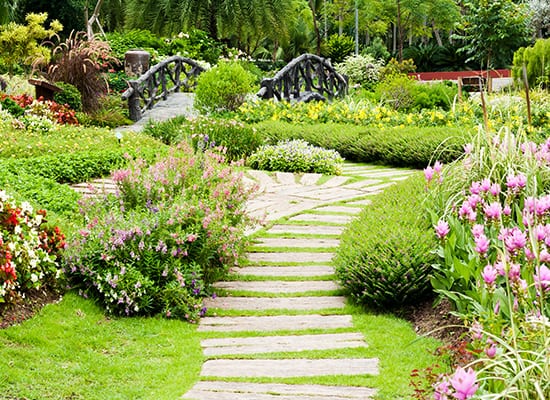
Garden Design & the Role of the Designer
This unit introduces you to the purpose of garden design and the development of key garden design trends. In addition, it teaches you about the role and responsibilities of the garden designer and the main principles garden designers work with in the present day. This unit also includes:
- The history and development of garden design and key styles
- The effect garden design history has on contemporary gardens
- Skills required to fulfil the role of garden designer
- Stages of the garden design process
- The importance of the design brief
- Working with clients and other professionals
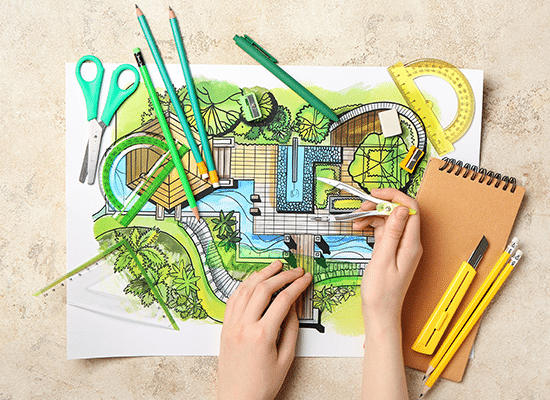
Garden Design Principles
Within this unit, you will learn about the components that make up a garden, exploring core elements that are common within a successful design scheme. You will learn how these ingredients work together to influence the appearance, usability and function of a garden space. This unit also includes:
- Applying techniques to create a sense of movement through the space or to highlight a focal point
- Using scale and proportion that relates to the property and the practical use of space
- The use of colour, texture and form to create a variety of moods in an exterior space
- Creating a variety of effects using garden components: boundaries, structures, planting, soft & hard landscape
- Creating balance, unity and cohesion within a scheme
- Light and shade as part of the garden design
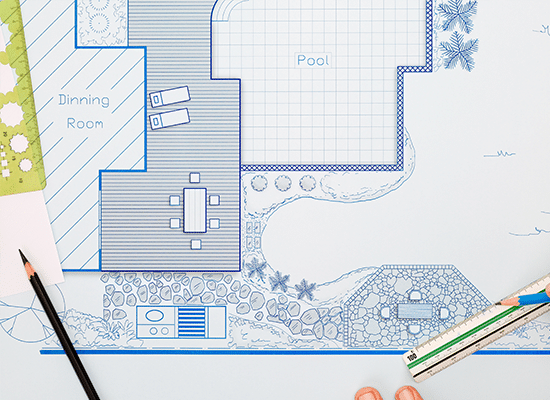
Exploring Site Surveys & Drawing Plans
Within this unit, you will learn how to measure a garden space and draw it to scale. You will also learn how gather important information about the site and how this information will influence your garden design decisions. You will develop drawing skills and produce your own site survey plan. This unit also includes:
- Site surveying – how & what to measure or record on site
- Surveying tools
- Understanding scale
- Developing site survey plans to scale, step by step
- Hand drawn or CAD – students may produce either
- Industry standard drawing conventions
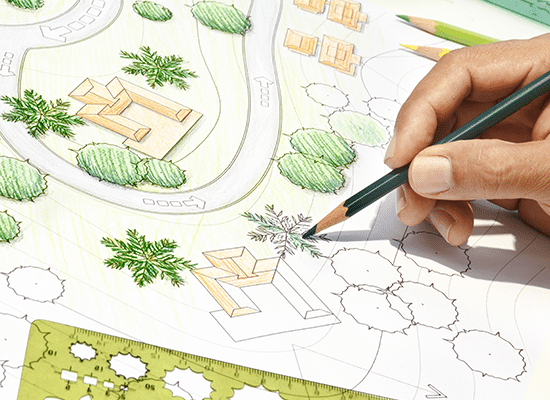
Space Planning & Garden Design Development in a Professional Context
This unit will inspire your creativity by developing your garden design skills. You will develop spatial planning skills and explore innovative ideas related to the aesthetics and practicality of garden layout. You will learn how to produces sketches, technical plans and elevations, how to select your strongest designs in relation to client briefs, as well as how to present this information professionally to clients, trade or contractors. This unit also includes:
- Developmental space planning techniques
- Exploring layout composition
- Traffic flow and effective zoning of space
- Drawing plans to scale
- Drawing elevations to show vertical dimensions and to propose elements such as boundaries, steps, raised beds, furniture and planting forms
- Ensuring successful practical and creative designs for your clients
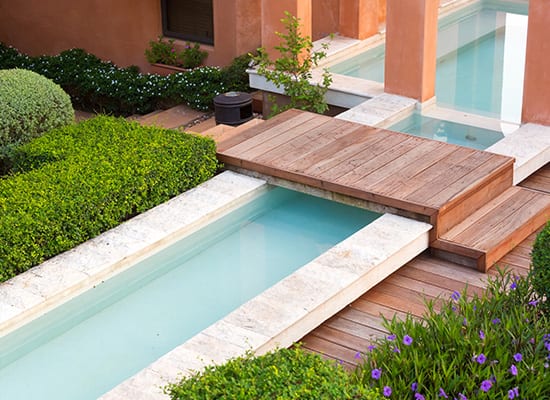
Hard Landscaping, Furniture, Lighting & Accessories
This unit focuses on products and materials for hard landscaping and water features, along with the items that provide the finishing touches to the garden space, such as furniture, lighting and accessories. You will explore products and materials for their practical, ethical, and aesthetic characteristics, making suitable choices for a garden scheme and presenting these to meet a client brief. This unit also includes:
- Products and materials for hard landscaping, water features, furniture, lighting and accessories in garden design
- Practical and aesthetic qualities and suitability for use in an outside space
- Selecting, sourcing and using products and materials
- Incorporating products and materials in your design
- Visually communicating your ideas, the professional way
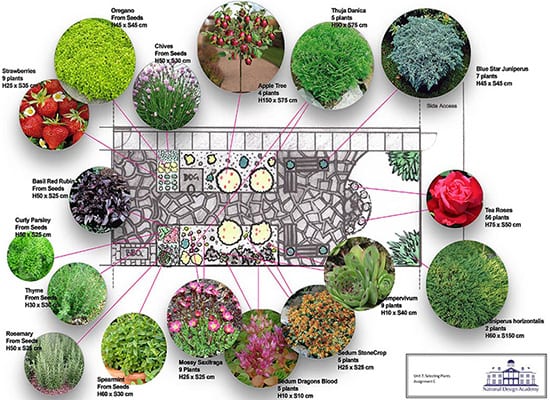
Planting Design
This unit will help you to understand plant biology, the environmental requirements of plants and the importance of selecting appropriate planting as part of your design. It looks at how you source your plants and the practical and aesthetic considerations to be considered when developing a planting plan to a design brief. In addition, you will learn how to present planting plans and specifications to a professional standard. This unit also includes:
- Plant identification and plant features: flowers, fruits, leaves, stems
- Plant names and classification
- Basic plant biology and environmental requirements
- The role of plants in the garden
- Selection & design for site context, functionality and client requirements
- Selection & design for visual aesthetics
- Production of planting plans and specifications

Professional Practice in Garden Design
This unit explores the wide array of creative and technical roles and diverse possibilities for professional engagement and career progression in this dynamic and competitive industry. It will help to prepare you to work successfully in the professional environment, whether for an established practice or setting up a garden design business. With a focus on your personal and professional development, you will consider the steps you should take to achieve your own progression ambitions. This unit also includes:
- Being employed, self-employed and setting up a garden design service
- Portfolio development
- Working with others in a professional environment
- Effective marketing and promotion
- How to cost garden design projects and services
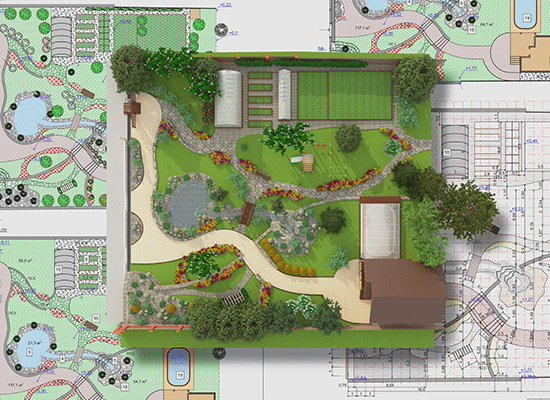
Professional Garden Design Project
For the final unit of the course, you bring together all your newly learned skills by producing conceptual designs and a design pack to create a wonderful garden design for a new client. When complete, your work will form an asset to your developing portfolio to show future clients. This unit also includes:
- Design development
- Reflecting on the challenges to enhance your final concept plan
- Preparing a rationale
- Professional presentation techniques

Garden Design & the Role of the Designer
This unit introduces you to the purpose of garden design and the development of key garden design trends. In addition, it teaches you about the role and responsibilities of the garden designer and the main principles garden designers work with in the present day. This unit also includes:
- The history and development of garden design and key styles
- The effect garden design history has on contemporary gardens
- Skills required to fulfil the role of garden designer
- Stages of the garden design process
- The importance of the design brief
- Working with clients and other professionals

Garden Design Principles
Within this unit, you will learn about the components that make up a garden, exploring core elements that are common within a successful design scheme. You will learn how these ingredients work together to influence the appearance, usability and function of a garden space. This unit also includes:
- Applying techniques to create a sense of movement through the space or to highlight a focal point
- Using scale and proportion that relates to the property and the practical use of space
- The use of colour, texture and form to create a variety of moods in an exterior space
- Creating a variety of effects using garden components: boundaries, structures, planting, soft & hard landscape
- Creating balance, unity and cohesion within a scheme
- Light and shade as part of the garden design

Exploring Site Surveys & Drawing Plans
Within this unit, you will learn how to measure a garden space and draw it to scale. You will also learn how gather important information about the site and how this information will influence your garden design decisions. You will develop drawing skills and produce your own site survey plan. This unit also includes:
- Site surveying – how & what to measure or record on site
- Surveying tools
- Understanding scale
- Developing site survey plans to scale, step by step
- Hand drawn or CAD – students may produce either
- Industry standard drawing conventions

Space Planning & Garden Design Development in a Professional Context
This unit will inspire your creativity by developing your garden design skills. You will develop spatial planning skills and explore innovative ideas related to the aesthetics and practicality of garden layout. You will learn how to produces sketches, technical plans and elevations, how to select your strongest designs in relation to client briefs, as well as how to present this information professionally to clients, trade or contractors. This unit also includes:
- Developmental space planning techniques
- Exploring layout composition
- Traffic flow and effective zoning of space
- Drawing plans to scale
- Drawing elevations to show vertical dimensions and to propose elements such as boundaries, steps, raised beds, furniture and planting forms
- Ensuring successful practical and creative designs for your clients

Hard Landscaping, Furniture, Lighting & Accessories
This unit focuses on products and materials for hard landscaping and water features, along with the items that provide the finishing touches to the garden space, such as furniture, lighting and accessories. You will explore products and materials for their practical, ethical, and aesthetic characteristics, making suitable choices for a garden scheme and presenting these to meet a client brief. This unit also includes:
- Products and materials for hard landscaping, water features, furniture, lighting and accessories in garden design
- Practical and aesthetic qualities and suitability for use in an outside space
- Selecting, sourcing and using products and materials
- Incorporating products and materials in your design
- Visually communicating your ideas, the professional way

Planting Design
This unit will help you to understand plant biology, the environmental requirements of plants and the importance of selecting appropriate planting as part of your design. It looks at how you source your plants and the practical and aesthetic considerations to be considered when developing a planting plan to a design brief. In addition, you will learn how to present planting plans and specifications to a professional standard. This unit also includes:
- Plant identification and plant features: flowers, fruits, leaves, stems
- Plant names and classification
- Basic plant biology and environmental requirements
- The role of plants in the garden
- Selection & design for site context, functionality and client requirements
- Selection & design for visual aesthetics
- Production of planting plans and specifications

Professional Practice in Garden Design
This unit explores the wide array of creative and technical roles and diverse possibilities for professional engagement and career progression in this dynamic and competitive industry. It will help to prepare you to work successfully in the professional environment, whether for an established practice or setting up a garden design business. With a focus on your personal and professional development, you will consider the steps you should take to achieve your own progression ambitions. This unit also includes:
- Being employed, self-employed and setting up a garden design service
- Portfolio development
- Working with others in a professional environment
- Effective marketing and promotion
- How to cost garden design projects and services

Professional Garden Design Project
For the final unit of the course, you bring together all your newly learned skills by producing conceptual designs and a design pack to create a wonderful garden design for a new client. When complete, your work will form an asset to your developing portfolio to show future clients. This unit also includes:
- Design development
- Reflecting on the challenges to enhance your final concept plan
- Preparing a rationale
- Professional presentation techniques
Student Gallery
A sample of work completed by our talented garden design students
One Course, Two Ways To Study
Choose from flexible online learning or online fast-track (zoom lectures).
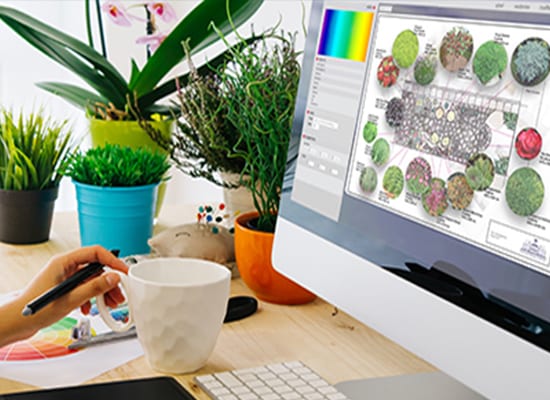
Online Flexible
8–10 Months (Flexible)
The online Professional Diploma course is designed to be flexible to allow you to study around your career, family, and other commitments. Choose your own start date and study from anywhere in the world as long as you have an internet connection.
The online diploma is a 8-10 month course however, many students who have more time to study complete earlier. All assignments consist of design projects which are assessed by your Personal Tutor – there are no examinations.
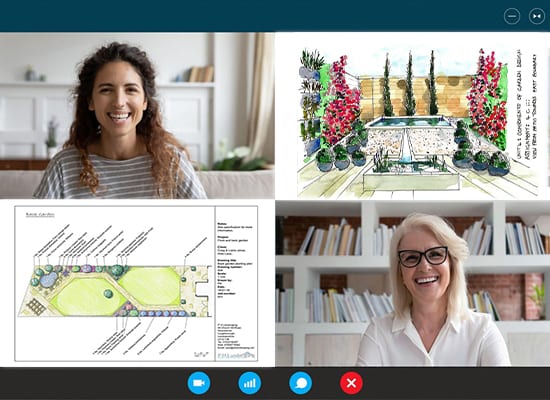
Online Fast-Track
14 weeks home study and weekly online lectures (via zoom)
For students who want all the benefits of remote online learning, but are also looking for more structure and live interaction with tutors and peers, the ‘Online Fast-Track’ course offers an ideal mix.
The course consists of a 8-week study period that covers each of the 10 subject units in the Diploma course, one unit per week. Up to 6 ‘Independent Study’ weeks within the duration of your course to complete any unfinished assignments. 2.5hr live lectures are organised two days per week.
- UK Government Funding (Diploma)
UK residents pay approximately 50% course fees and funding from the UK government will pay the rest.
Accreditation
All NDA Professional Diplomas are accredited by AIM Awards. NDA is the only design school to be able to offer funding & student loans because our Diplomas are fully accredited.
Online (Flexible) Diploma Course Fees
UK Students
Course Fee £1,590
UK Government Funding
There are two ways for UK students to pay for their Online (Flexible) Diploma:
International Students
There are two ways for International students to pay for their Online (Flexible) Diploma:
International fees in US dollars.
What Will I Need To Study?
Alongside a computer and an internet connection, there is also essential and recommended design equipment required to complete your NDA Course, all available through the NDA Art Shop at student prices!
What's Next?
Interested in studying at Degree level? See if you already qualify for the BA (Hons) Design for Outdoor Living here. If not, all of our Diploma students will be guaranteed a place on the degree upon completion.
Higher Education
Once you have successfully completed the NDA Diploma in Professional Garden Design, you a will be offered a guaranteed place onto one of our online degree courses, such as BA (Hons) Design for Outdoor Living, with a generous Progression Scholarship. Degrees are awarded by our academic partner, De Montfort University Leicester (DMU), and they are studied online in the same way as your Diploma.
Careers
The Diploma in Professional Garden Design is designed to help you start your own Garden Design business. Like the Diploma course itself, you can work flexibly for your clients around your family commitments and gradually expand your business. Many of our Diploma students start their own business and study for their degree flexibly alongside their client projects.
Ready to pursue your passion for Garden Design?
What Our Students Say...
Hear what past and present students have to say about studying at the NDA
